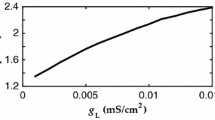Abstract
Rhythmic movements of crayfish swimmerets are coordinated by a neural circuit that links their four abdominal ganglia. Each swimmeret is driven by its own small local circuit, or pattern-generating module. We modeled this networkas a chain of four oscillators, bidirectionally coupled to their nearest neighbors, and tested the model‘s ability to reproduce experimentally observed changes in intersegmental phases and in period caused by differential excitation of selected abdominal ganglia. The choices needed to match the experimental data lead to the followingpredictions: coupling between ganglia is asymmetric; the ascending and descending coupling have approximately equal strengths; intersegmental coupling does not significantly affect the frequency of the system; and excitation affects the intrinsic frequencies of the oscillators and might also change properties ofintersegmental coupling.
Similar content being viewed by others
References
Acevedo LD, Hall WM, Mulloney B (1994) Proctolin and excitation of the crayfish swimmeret system. J. Comp. Neurol.345:612–627.
Bizzi E, Giszter SF, Loeb E, Mussa-Ivaldi FA, Saltiel P (1995) Modular organization of motor behavior in the frog’s spinal cord. TINS 18:442–446.
Braun G, Mulloney B (1993) Cholinergic modulation of the swimmeret system in crayfish. J. Neurophysiol.70:2391–2398.
Braun G, Mulloney B (1995) Coordination in the crayfish swimmeret system: Differential excitation causes changes in intersegmental phase. J. Neurophysiol.73:880–885.
Chrachri A, Clarac F (1990) Fictive locomotion in the fourth thoracic ganglion of the crayfish. J. Neurosci.10:707–719.
Cohen AH (1987) Intersegmental coordinating system of the lamprey central pattern generator for locomotion. J. Comp. Physiol. [A] 160:181–193.
Cohen AH, Ermentrout GB, Kiemel T, Kopell N, Sigvardt KA, Williams TL (1992) Modelling of intersegmental coordination in the lamprey central pattern generator for locomotion. TINS 15:434–438.
Delcomyn F (1980) Neural basis of rhythmic behavior in animals. Science210:492–498.
Ermentrout GB, Kopell N (1991) Multiple pulse interactions and averaging in systems of coupled neural oscillators. J. Math. Biol. 29:195–217.
Friesen WO, Pearce RA (1993) Mechanisms of intersegmental coordination in leech locomotion. Semin. Neurosci.5:41–47.
Giszter SF, Mussa-Ivaldi FA, Bizzi E (1993) Convergent force fields organized in the frog’s spinal cord. J. Neurosci.13:467–491.
Grillner S (1985) Neurobiological bases of rhythmic motor acts in vertebrates. Science228:143–149.
Grillner S, Wallén P, Brodin L, Lansner A (1991) Neuronal network generating locomotor behavior in lamprey: circuitry, transmitters, membrane properties, and simulation. Ann. Rev. Neurosci.14: 169–199.
Grillner S, Deliagina T, Ekeberg Ö, El Manira A, Hill RH, Lansner A, Orlovsky GN, Wallén P (1995) Neural networks that coordinate locomotion and body orientation in lamprey. TINS18:270–279.
Horn RA, Johnson CR (1985) Matrix Analysis. Cambridge University Press, Cambridge, MA.
Ikeda K, Wiersma CAG (1964) Autogenic rhythmicity in the abdominal ganglion of the crayfish: The control of swimmeret movements. Comp. Biochem. Physiol.12:107–115.
Kopell N (1988) Toward a theory of modelling central pattern generators. In: Cohen AH, Rossignol S, Grillner S, eds., Neural Control of Rhythmic Movements in Vertebrates. Wiley, New York, pp. 369–413.
Kopell N, Ermentrout GB (1986) Symmetry and phaselocking in chains of weakly coupled oscillators. Comm. Pure App. Math. 39:623–660.
Kopell N, Ermentrout GB (1988) Coupled oscillators and the design of central pattern generators. Math. Biosci.90:87–109.
Kopell N, Ermentrout GB (1990) Phase transitions and other phenomena in chains of coupled oscillators. SIAM J. Appl. Math. 50:1014–1052.
Mulloney B, Murchison D, Chrachri A (1993) Modular organization of pattern-generating circuits in a segmental motor system: The swimmerets of crayfish. Semin. Neurosci.5:49–57.
Mulloney B, Hall W (1995) How are the limbs on different segments of the body coordinated? A test of the "excitability gradient" hypothesis in the swimmeret system. Soc. Neurosci. Abst.21:505.2.
Murchison D, Chrachri A, Mulloney B (1993) A separate local pattern-generating circuit controls the movements of each swimmeret in crayfish. J. Neurophysiol.70:2620–2631.
Paul DH, Mulloney B (1986) Intersegmental coordination of swimmeret rhythms in isolated nerve cords of crayfish. J. Comp. Physiol.
Roberts A (1990) How does a nervous system produce behaviour? A case study in neurobiology. Science Progress74:31–51.
Sigvardt KA (1993) Intersegmental coordination in the lamprey central pattern generator for locomotion. Semin. Neurosci.5:3–15.
Sigvardt KA, Williams TL (1997) Effects of local oscillator frequency on intersegmental coordination in the lamprey locomotor CPG: theory and experiment. J. Neurophysiol.(In press).
Sillar KT, Clarac F, Bush BMH (1987) Intersegmental coordination of central neural oscillators for rhythmic movements of the walking legs in crayfish, Pacifastacus leniusculus. J. Exp. Biol. 131:245–264.
Stein PSG (1969) A Neurophysiological Study of Two Systems of Coupled Oscillators in Crayfish. Stanford University.
Stein PSG (1971) Intersegmental coordination of swimmeret motor neuron activity in crayfish. J. Neurophysiol.34:310–318.
Stein PSG, Victor JC, Field EC, Currie SN (1995) Bilateral control of hindlimb scratching in the spinal turtle: Contralateral spinal circuitry contributes to the normal ipsilateral motor pattern of fictive rostral scratching. J. Neurosci.15:4343–4355.
Tunstall MJ, Sillar KT (1993) Physiological and developmental aspects of intersegmental coordination in Xenopusembryos and tadpoles. Semin. Neurosci.5:29–40.
Wiersma CAG, Hughes GM (1961) On the functional anatomy of neuronal units in the abdominal cord of the crayfish, Procambarus clarkii. J. Comp. Neurol.116:209–228.
Williams TL (1992) Phase coupling in simulated chains of coupled oscillators representing the lamprey spinal cord. Neural Computation. 4:546–558.
Williams TL, Sigvardt KA (1994) Intersegmental phase lags in the lamprey spinal cord: Experimental confirmation of the existence of a boundary region. J. Comput. Neurosci.1:61–68.
Williams TL, Sigvardt KA, Kopell N, Ermentrout GB, Remler MP (1990) Forcing of coupled nonlinear oscillators: Studies of intersegmental coordination in the lamprey locomotor central pattern generator. J. Neurophysiol.64:862–871.
Author information
Authors and Affiliations
Rights and permissions
About this article
Cite this article
Skinner, F.K., Kopell, N. & Mulloney, B. How Does the Crayfish Swimmeret System Work? Insights from Nearest-Neighbor Coupled Oscillator Models. J Comput Neurosci 4, 151–160 (1997). https://doi.org/10.1023/A:1008891328882
Issue Date:
DOI: https://doi.org/10.1023/A:1008891328882




